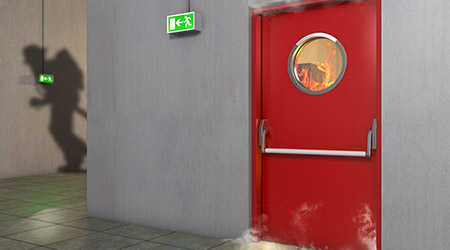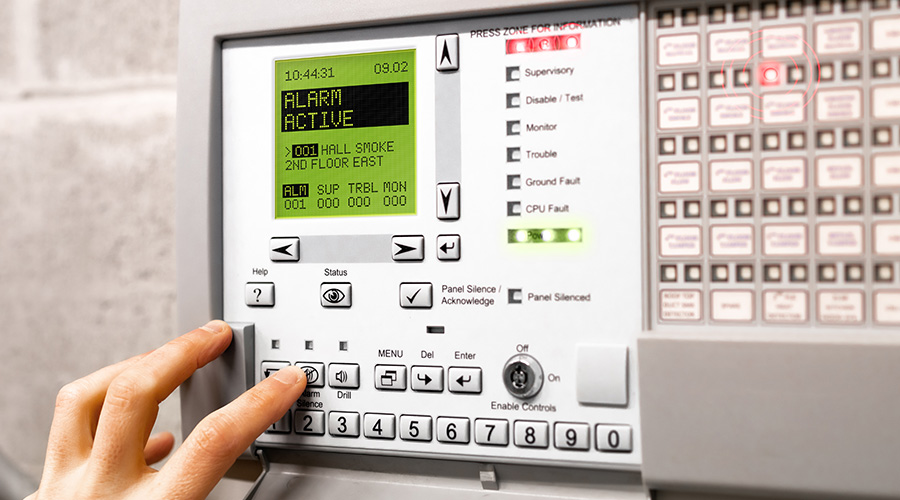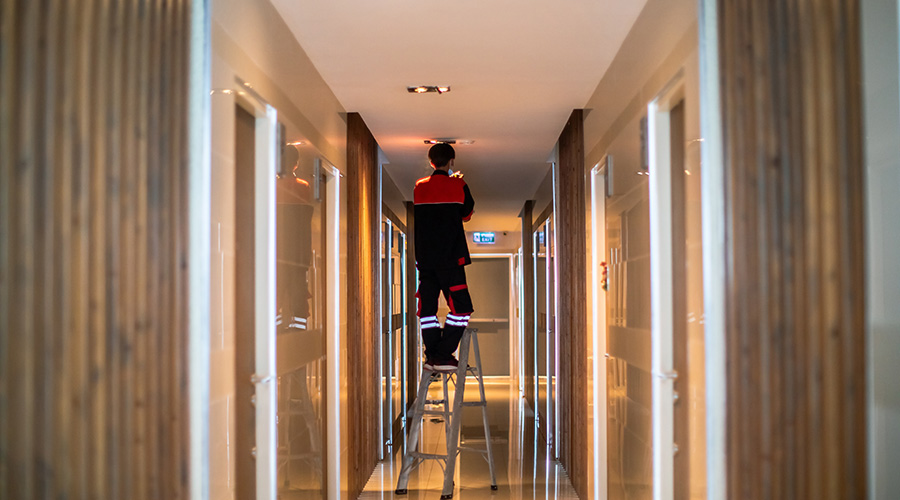What You Need to Know About Fire Door Inspection, Testing, and Maintenance
Changes to NFPA 80 clarify actions managers must take to protects occupants, assets, and facilities.
Nearly 15 years ago, changes to National Fire Protection Association (NFPA) 80, Standard for Fire Doors and Other Opening Protectives, mandated annual inspections for fire doors. The changes were the result of the realization that of the condition of most existing fire doors would not provide proper protection during a fire in institutional and commercial facilities.
Maintenance and engineering managers assumed local fire marshals would conduct the inspections, while most fire marshals said they did not have the necessary manpower to do so. In addition, the standard was included only as a referenced standard and was not directly written into building codes.
Today, the situation is changing. NFPA 80 is being adopted into building codes not just as a reference but as a requirement. These codes include: NFPA 101 — Life Safety Code, which is used in many jurisdictions; the International Fire Code that is used by states as their fire codes; and the International Building Code, which is perhaps the most widely used building code.
One of the most significant changes that this has for managers is the requirement for annual inspection and testing of all fire doors. In most cases, the building owner is responsible for carrying out and documenting the inspections. The intent of the regulation is to give the authorities having jurisdiction (AHJ) the ability to see and review the fire door inspection documentation, just as they have been doing with sprinkler systems, fire extinguishers, alarms, and other fire safety systems. With that authorization, more fire marshals are asking to see that documentation during their annual inspection of the facility.
Why the attention to fire doors? Post-fire examinations have shown that fire-related injuries and deaths have occurred as a result of improperly functioning fire doors. Something as simple as a broken door closer or a failed door latch can keep a fire door from properly closing, allowing the spread of flames and smoke through the opening. A well maintained and properly operating fire door would have limited the spread of to protect the building and its occupants.
Fire door locations
One problem managers face when conducting their first fire door inspection is locating all of the installed fire doors. Code determines where fire doors must be installed, so understanding that the two primary intents of the code are to stop the spread of smoke and fire and to provide a safe path of egress in the event of a fire will help managers identify fire door locations.
To stop the spread of smoke and fire, fire doors are located between discrete areas of the building, in corridors between building sections, and in interior stairwells. Similarly, fire doors are located at all points of egress from the building, including entrances, exits, and lobbies.
Fire doors and their frames must be labeled, showing the door manufacturer and the fire protection rating of the assembly. Examine all doors and door frames closely for fire door labels. But just because a door does not have a label does not mean it is not a fire door. Unfortunately, over the years, many labels have been painted over or otherwise rendered unreadable.
Other factors that help identify a fire door include the hardware installed on the door and signage. If the door has a closer and panic hardware, it is most likely a fire door. Similarly, if a sign states that the door must remain closed, it probably is a fire door.
Inspection Requirements
NFPA 80 spells out specific items to inspect and tests that are to be performed on each fire door. At a minimum, managers must ensure the following tasks are performed:
- Check for missing, damaged, or painted over fire door labels. Missing or damaged labels might cause the AHJ to require recertification or replacement of the door.
- Check that no parts of the door or frame are missing or broken.
- Check that no hardware or other items have been added to the door or frame that could interfere with its proper operation.
- Inspect the entire door and frame for open holes or breaks in surfaces.
- Inspect all door hardware, gaskets, and edge seals for damage.
- Check the latching hardware to ensure it secures the door when in the closed position.
- Test the self-closing device to ensure it completely closes the door when activated from a full-open position.
- Inspect glazing and vision panels to ensure they are intact and securely fastened in place.
- Check the alignment of the door, frame, hinges, and hardware to ensure they are secure and in good working order.
- Measure door clearances. The maximum allowable gap under the bottom of the door is three-quarters of an inch. The maximum allowable gap along the top, hinge, and latch edges is one-eighth of an inch.
- Ensure that the inactive leaf of a double door closes before the active leaf.
These steps represent the minimum inspection and testing requirements. The most common defects found during a typical inspection include: failure of the door latch to properly secure the closed door; damaged or missing door closer; painted over or missing door or frame label; blocked door; and an excessive gap between the door and the frame or floor. All identified defects should be corrected as quickly as possible.
Who Can Inspect
It is not necessary to use a certified door inspector to perform the annual testing and inspections. Section 3.3.96 of NFPA 80 defines a qualified person for performing the tests and inspections as, “A person who, by possession of a recognized degree, certificate, professional standing, or skill, and who, by knowledge, training, and experience, has demonstrated the ability to deal with the subject matter, the work, or the project.”
According to the NFPA definition, no certification is required. This gives managers two options: in-house performance of the testing and inspections and outsourcing. For in-house inspections, the department might already have qualified personnel to perform the tasks. If not, managers can have personnel attend a training session that specifically targets fire door inspections. If a number of personnel need to be trained, managers can have a qualified outside person conduct the training on-site. The key is to make certain the in-house personnel performing the inspections are knowledgeable concerning doors and have been trained as to the requirements of the regulation.
Outsourcing is an effective way to perform the inspections if there are no qualified in-house personnel or if the sheer number of fire doors is overwhelming. A number of companies are well-qualified to perform the inspections, including engineering and architectural firms, maintenance organizations, and door vendors.
Fire door inspection report
When fire door inspections are finished, managers must closely examine the report documents. The report should include a separate page for each fire door. In addition to the items inspected and tested, each page should include a form of identification for the door, such as an assigned number or location, the type of door installed, its fire rating, the date the inspection was conducted, and the name and signature of the person conducting the inspection. An additional comments section should be included to allow inspectors to identify unusual circumstances or conditions.
In addition to each door inspection sheet, it might be necessary to include photographs of conditions of a particular door. Those photographs should be clearly labeled to identify the door, location of the defect on the door or frame, and the condition. The AHJ will request these documents when conducting an annual inspection of a facility.
Prioritizing repairs
The first fire door inspection report most likely will include a long list of deficiencies, ranging from minor ones to others that require replacement of the door and frame. Deficiencies also might include failed latches, excessive door to frame and floor gaps, missing fire labels, damages or missing hardware, and improperly blocked doors.
While the sheer number of deficiencies can be overwhelming, particularly when conducting the first annual inspection, it is essential that managers review the report carefully to determine actions that need to be taken where and when. Chances are managers will not be able to correct all of them, so they will have to set priorities. Some fixes will be easy and inexpensive, while others will not, so managers will have to set priorities and repair schedules. If managers need help setting priorities, consult with a third-party fire safety expert.
James Piper, Ph.D., PE, is a writer and consultant who has more than 35 years of experience in facilities management.
Related Topics:












